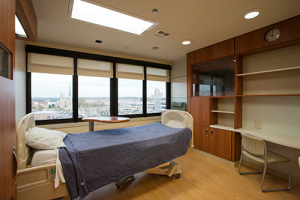Safety for All: Integrated Design for Inpatient Units
By James M. Hunt, AIA, NCARB: and David M. Sine, DrBE, CSP, ARM, CPHRM
The concept of integrated healthcare – treating the whole person and all of his or her diagnoses, including mental illness, in one location with one team of clinicians—has gained considerable traction in the literature (U.S. Department of Health & Human Services, n.d.). The discussion has largerly centered on outpatient treatment modalities, medical records, organizational structure, and other aspects of implementing this concept. It seems odd, given the importance of the environment to patient care, that the design of inpatient units has largely been missing in this evolving discussion of facilities where integrated treatment may be safely provided to all patients.
When designing integrated inpatient facilities, it is necessary to prepare for the possibility that mental health patients may attempt to harm themselves or others. In addition to patients with known mental health conditions, patients who are taking prescription medications for conditions such as depression but who are not identified specifically as mental health patients must also be considered. All patients will benefit from a facility that has been designed with safety in mind. Contrary to common assumptions, fixtures and design elements used in modern mental health hospitals are functional, attractive, and safer for all patients, regardless of mental health status (Figure 1).

Patients with unidentified mental health issues
Studies show that the use of mental health medications varies by region, with a range from 14.6% to 23.3% of the general population (Medco Health Solutions, 2011). Therefore, it can be assumed that a significant percentage of patients being seen in integrated care treatment facilities may be using some form of prescribed mental health medication. Some of these patients may suffer from depression or suicidal ideation, which may be further exacerbated by a comorbidity, such as a serious physical condition. Therefore, it is necessary to provide an environment that is safe for them. The potential risk of self-harm by these patients within the integrated system of care must be addressed, and part of that preparation should be the safe design of the treatment unit.
Patients with known mental health issues
The earliest example of a general hospital admitting psychiatric patients was the hospital of Saint Maria della Petra Rome, founded in the 15th century and “dedicated to the care of all sick people, including those who are mentally sick.” In the United States, Pennsylvania Hospital treated its first group of mentally ill patients, who were “admitted to the cellar,” in 1756 (Meyerson & Davis, 1983). By the early 19th century, the design of mental health treatment facilities was based largely on a strong belief that architectural design was of “cardinal importance” and inseparable from any plan of treatment (Porter, 2002).
On a medical unit, patients spend the vast majority of their time in their rooms waiting for or receovering from specific medical interventions. The patient rooms are where they see their doctors, eat their meals, receive visitors, and, with the exception of specialty tests and treatments, receive the majority of their care. In a psychiatric facility, however, none of those activities occur in the patients’ rooms. Patients are expected to be out of their rooms participating in activities or interacting with other patients and staff during the day. These two types of facilities require completely different design approaches.
Unfortunately, patients who have both a medical as well as a mental health condition do not fit comfortably into either the traditional mental health or medical treatment systems and often fall through the cracks because neither system is equipped to take care of them. They are more likely to be found in hospitals than on inpatient psychiatric units and often present to the emergency department with injuries and serious illnesses (Bernstein, 1996).
Mental health patients who find themselves being treated on a medical unit often find ways to make their dissatisfaction felt – by escaping, committing suicide, starting a lawsuit, or simply complaining to their relatives (Tomes, 1994). In addition, it may be difficult to follow up with and provide aftercare for these patients, and they have very high rates of recidivism and readmissions for their illnesses. They tend to have multiple service needs, confounding attempts to provide a coordinated continuum of care (Bernstein, 1996). For these reasons, it is much better to treat patients presenting with mental health issues only (with no medical issues) in a unit specifically designed for mental health patients. The inpatient treatment process, and herefore the physical design of the treatment spaces, is completely different for mental health patients. They need group therapy rooms, activity rooms, day rooms, seclusion rooms, and consultation and interview rooms, all of which are typically unique to a mental health treatment unit. In addition, it is unrealistic to provide those spaces if the patient is receiving medical treatment and, therefore, not ambulatory or able to participate in group functions. Inpatient psychiatric patients who do not have a co-occurring medical condition requiring treatment will always need a separate environment.
Managing the risk of self-harm
There is inherent risk that medical equipment may be used for self-harm. The current common practice, therefore, is to assign known mental health patients in need of medical treatment to medical/surgical units and assign a sitter to observe them at all times. One recent study reported, however, that nine of the 72 suicides investigated had been successful despite one-on-one observation (Busch, Fawcett, & Jacobs, 2003). The Joint Commission reported in 1998 that in the previous two years, it had reviewed 65 inpatient suicides, 17 of which (26%) had occurred in non-psyciatric environments (The Joint Commission, 1998). In addition, competing treatment prioirites in the medical/surgical environment mean that staff members may not be familiar with, or trained to treat patients with mental illnesses. That may result in, among other things, psychotropic medications not getting the close attention they require. Potentially detrimental drug interaction may go unnoticed until undesired outcomes have occurred.
